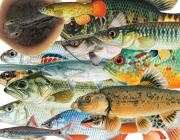GPLCC grant
Project Partners: (links open in new tab) Hendrickson lab (Fishes of Texas Project group), Great Plains Landscape Conservation Cooperative (GPLCC), Great Plains Fish Habitat Partnership, Southeast Aquatic Resources Partnership, Texas Parks and Wildlife Department (TPWD)
Project Goal: The GPLCC supported efforts by the partners referenced above to utilize this multi-species, watershed-based framework to facilitate cooperative planning and collaborative conservation of aquatic resources within the GPLCC’s multi-jurisdictional landscape.
Project Objective: Identify priority conservation actions and research needs for focal fish species and priority watersheds of the GPLCC through a series of watershed-specific workshops to obtain expert input, select critical management zones, identify potential conservation actions, and identify priority data and science needs that must be addressed in order to guide conservation actions.
Project Benefits: This project sought to advance the cooperative conservation of Great Plains rivers and native fishes, and provide a catalyst for development of watershed-based conservation partnerships that will implement a proposed network of Native Fish Conservation Areas in the region.
Background: Through earlier support from the Great Plains Landscape Conservation Cooperative (GPLCC) (Labay and Hendrickson (2014) and Hendrickson et al. 2016) used Species Distribution Models from our Fishes of Texas Project in a conservation assessment that provides a spatial framework for planning and implementing conservation actions to benefit 28 priority fishes in rivers of the Great Plains. That assessment provided data-driven guidance and science-based justification for selection of priority river systems to advance watershed-scale conservation planning and delivery in the Great Plains. In particular, the Native Fish Conservation Areas (NFCAs) analysis identified a set of watersheds uniquely valued in preservation of regional fish diversity.
Update (November 2017): We publish updated content from this project in the webpages of the Native Fish Conservation Network. For each NFCA identified in the conservation assessment, regional stakeholders formed Advisory Councils that focus on facilitating cooperative conservation of native fishes and other aquatic resources. Watershed-based conservation planning workshops have been conducted for the Native Fish Conservation Areas in the Platte, Arkansas, Canadian, Red, Brazos, and Colorado rivers and the Chihuahuan Desert of Texas. More than 135 subject-matter experts participated in these meetings and worked to (1) identify priority research, monitoring, and restoration actions for preservation of native fishes, their habitats and other aquatic resources, (2) catalyze cooperation, collaboration, and leveraging of technical and financial resources among the local, state and federal natural resources management agencies, universities, non-governmental organizations, and other local partners that contribute to the conservation of native fishes and other aquatic resources, and (3) facilitate local implementation of the Native Fish Habitat Action Plan. To date, participants have recommended approximately 230 project-level actions to conserve freshwater biodiversity in these priority watersheds.

